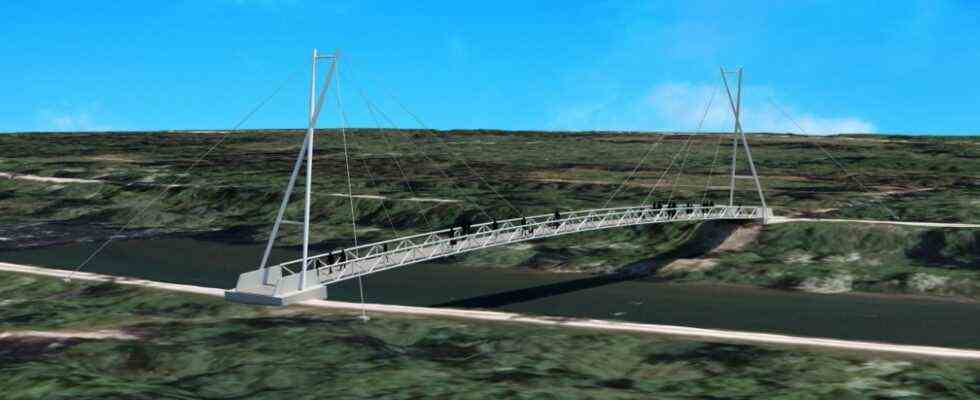What some cyclists who have been out and about in the north of the district have longed for, should soon become reality: If everything goes according to plan, another bridge between Ismaning and Garching will cross the Isar from 2023 and the Ismaning district of Fischerhäuser on the east bank and connect the TU research center on the west bank. The two municipalities and the district want to share the costs for the cable-stayed bridge.
The new bridge over the Isar could look something like this. The transition to the bank is made even gentler than in the picture. The construction, which will cost a good two million euros and will allow pedestrians and cyclists to cross the river, is due to be completed in 2023. Visualization: engineering office RoPlan Rosenheim
So far, cyclists and pedestrians have had to either drive or walk north from the northern Isar floodplains to Dietersheim, or use the bridge on the B 471 federal road to the south to get to the other side of the river. The new bridge also provides a direct connection between the subway at Garching-Forschungszentrum station and the bus line to and from Erding. Since there is a station for MVG bikes at the bus stop in Fischerhäuser as well as at the research campus, Ismaning’s Mayor Alexander Greulich (SPD) hopes to be able to motivate commuters from the north-east to switch to public transport in this way.
The idea for the bridge goes back to an application by the Ismaning SPD at the end of 2019 and quickly made friends on both sides of the Isar. The engineering office Ro-Plan from Rosenheim examined four locations in a feasibility study on behalf of the municipality of Ismaning and found a position on the Garching side roughly at the level of Gießenbachstrasse to be very suitable. From the Ismaning side, the Langes Geräum trail leads through the alluvial forest to the future bridge location. The district, the water management office, the recreation area association and the Bavarian State Forests see the project as fundamentally positive.
Since the bridge is being built in the Isarauen landscape protection and FFH area, the construction should interfere with nature as little as possible. The design by the engineering office Ro-Plan therefore provides for a cable-stayed bridge with steel trusses. This filigree construction manages without supports in the Isar, instead two crossed poles, so-called pylons, and associated steel cables hold the footbridge on each bank. The bridge will have a length of about 95 meters, the pylons will protrude according to the design about 22 meters in height. The engineering office has already built two similar bridges in Kolbermoor in the Rosenheim district; In contrast to the planned Isar bridge, these Mangfall footbridges are built with a box girder cross-section instead of steel girders.
The Ismaning municipal council has given the project its blessing and instructed the administration to submit a funding application to the government of Upper Bavaria as quickly as possible. If the municipality submits this by the end of August 2021, the project has the prospect of funding of up to 80 percent of the costs through the special program “City and Country”. However, this also assumes that the bridge is ready by 2023 – a “sporty schedule”, as Greulich says, but feasible. After an examination of species protection law, construction could begin in April 2022 and then be completed by mid-2023.
the new bridge over the Isar should be long. The stay cable construction with lattice girders made of steel and a total of four 22-meter high pillars connects the Ismaning district of Fischerhäuser on the east and the TU research center with its underground station on the west bank of the river.
Overall, the engineering office calculates the cost of the building, including the planning work that has already been done, at a good two million euros. After deducting the hoped-for funding, a good 400,000 euros remained to be paid. It is said that Ismaning, Garching and the district are still in talks about who will bear this sum and what proportions and how the future maintenance costs for the new bridge will be handled. The city of Garching has also asked the TU for a statement.

